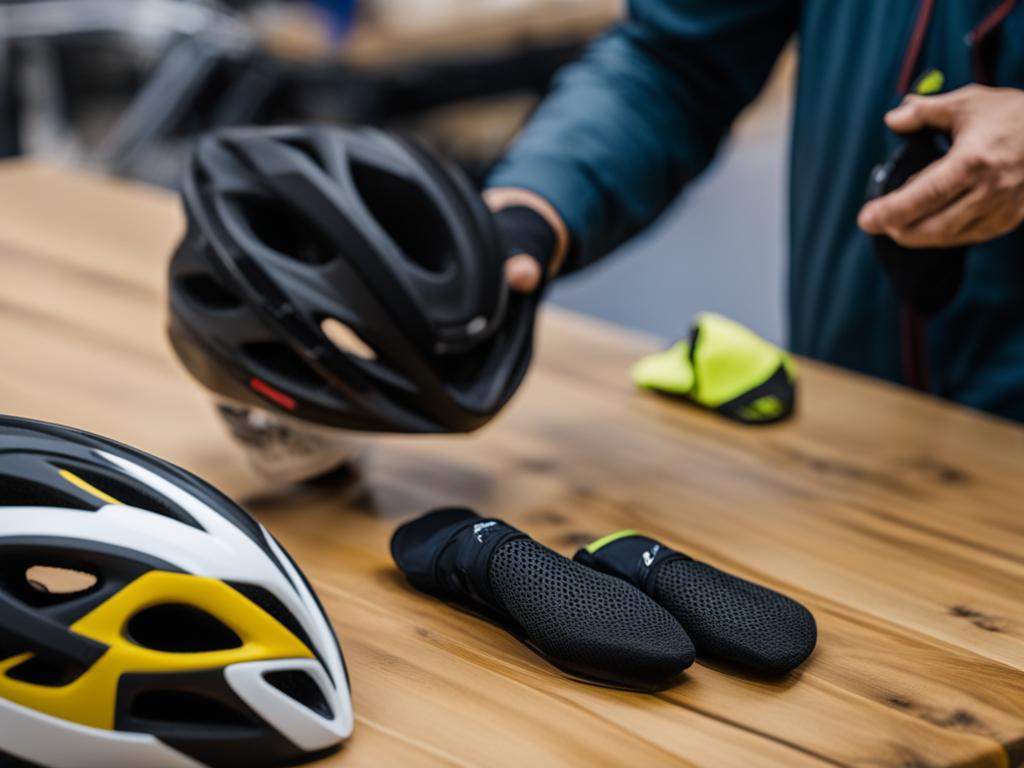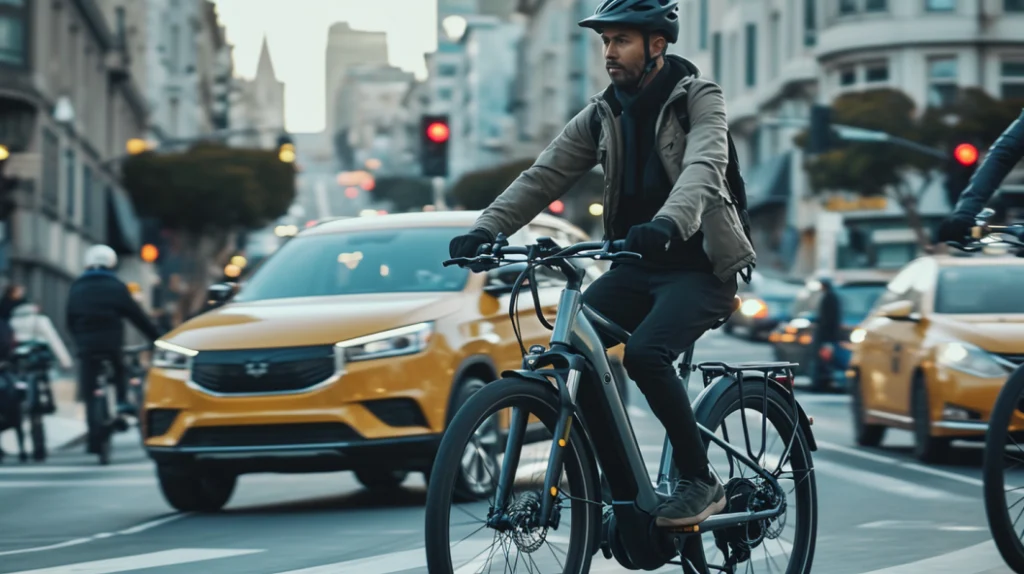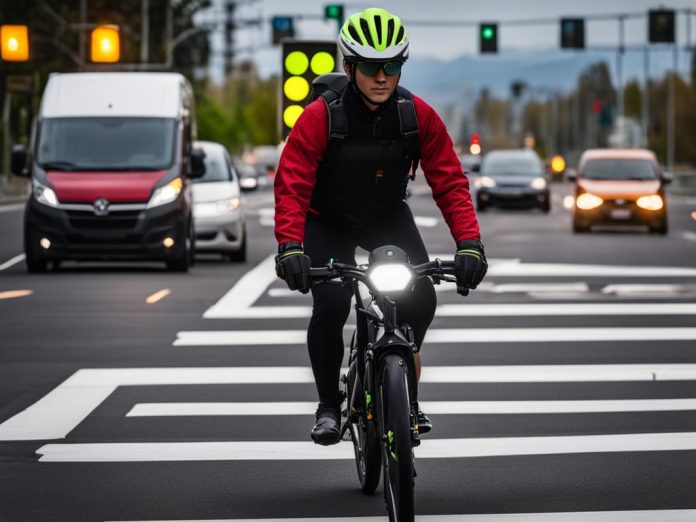E-bikes are becoming increasingly popular among beginner riders in the United States. We have provided this beginner’s guide to ebike safety to ensure a safe and worry-free ride. It is essential to equip yourself with the right gear, adhere to e-bike laws, and practice safe riding techniques. In this Beginners eBike safety essential Guide, we will explore the necessary steps to stay safe while enjoying your electric bicycle.
Table of Contents
Key Takeaways:
- Wearing a properly fitted helmet is crucial for beginners eBike Safety.
- Understanding and following e-bike laws and regulations is essential.
- Practicing safe riding techniques like signaling and maintaining a proper stance reduces the risk of accidents.
- Regular maintenance and inspections help ensure the safe operation of your e-bike.
- Being aware of riding conditions and sharing the road responsibly enhances safety for everyone.
Beginners eBike Safety Gear Essentials.
Wearing the right safety gear is vital for e-bike riders. As a beginner, it’s crucial to prioritize your safety on the road. The most important piece of equipment you should never ride without is a helmet. A properly fitted helmet can protect your head from potential injuries in case of accidents or falls. Make sure to always wear your helmet securely fastened, regardless of the distance or terrain.
In addition to a helmet, there are other beginners eBike safety gear you should consider:
- Reflective clothing: Wear bright and reflective clothing to enhance your visibility on the road, especially during low-light conditions such as dusk or dawn. Reflective materials help other road users spot you more easily and reduce the risk of accidents.
- Gloves: Invest in a good pair of cycling gloves to protect your hands from blisters and provide better grip on the handlebars. They also act as an extra layer of protection in case of falls.
- Closed-toe shoes: Opt for closed-toe shoes while riding to protect your feet from debris, impacts, and potential accidents. Sturdy shoes with rubber soles can also improve your grip on the pedals.
- Front and rear lights: It’s crucial to equip your e-bike with front and rear lights to enhance visibility, especially when riding in dimly lit areas or during nighttime. Lights alert other road users of your presence, reducing the risk of collisions.
By wearing the proper beginners eBike safety, you significantly reduce the chances of injuries and ensure a safer riding experience. Remember, your safety should always come first.

Ride with Confidence and Protection
“Investing in high-quality beginners eBike safety gear is an investment in your well-being. Don’t compromise on your protection. Embrace the journey with confidence and ride responsibly.”
Understanding E-Bike Laws
Familiarizing yourself with e-bike laws and regulations is crucial to ensure legal compliance and safe riding. In the United States, e-bike laws vary by state and can sometimes differ from traditional bicycle laws. It is essential to understand the classification of your e-bike (Class 1, 2, or 3) and any specific regulations for e-bike use in your area. Additionally, riders should adhere to general traffic rules, such as obeying traffic signals and yielding to pedestrians.
When it comes to e-bike laws, it’s important to know the specific requirements and restrictions set by your state. For example, some states may require e-bike riders to be a certain age or wear helmets, while others may restrict e-bike use on certain trails or roads. By familiarizing yourself with the laws, you can ensure that you are riding within the legal boundaries and minimizing the risk of penalties or accidents.
Here is a breakdown of the three main classes of e-bikes and their corresponding characteristics:
- Class 1: These e-bikes are equipped with a motor that provides assistance only when the rider is pedaling. The motor ceases to assist when the bike reaches a speed of 20 mph.
- Class 2: These e-bikes are equipped with a motor that can assist even without pedaling. The motor ceases to assist when the bike reaches a speed of 20 mph.
- Class 3: These e-bikes are equipped with a motor that provides assistance only when the rider is pedaling. The motor ceases to assist when the bike reaches a speed of 28 mph.
In addition to understanding e-bike classifications, riders should also adhere to general traffic rules and regulations. This includes obeying traffic signals, riding in the same direction as traffic, and yielding to pedestrians. By treating your e-bike like any other vehicle on the road, you can promote a safer and more harmonious riding experience for both yourself and other road users.
| State | E-Bike Class | Maximum Speed | Minimum Age | Helmet Requirement |
|---|---|---|---|---|
| California | Class 1, 2, and 3 | 20 mph | 16 | Under 18 |
| New York | Class 1 and 2 | 25 mph | 16 | All Ages |
| Texas | Class 1 | 20 mph | NA | Under 18 |
| Florida | Class 1, 2, and 3 | 28 mph | 16 | All Ages |
Table: E-Bike laws and regulations in select states
Riding Tips for E-Bike Law Compliance
Here are some key tips to help you ride your e-bike in compliance with the law:
- Research your state’s specific e-bike laws and regulations.
- Ensure your e-bike meets the classification requirements for your state.
- Wear a helmet whenever you ride, regardless of age or legal requirement.
- Obey all traffic signals, signs, and regulations.
- Ride in the same direction as traffic and use designated bike lanes when available.
- Yield to pedestrians and provide audible signals when passing.
- Be aware of any local restrictions on e-bike use, such as bike paths or trail access.
By understanding and complying with e-bike laws, you can ride confidently and responsibly, ensuring your safety and the safety of others on the road.

Riding Techniques for Beginners E-Bike Safety
Riding an e-bike can be a thrilling experience, but it’s important to prioritize safety at all times. By mastering safe riding techniques, you can enjoy your e-bike adventures while minimizing the risk of accidents or injuries. Whether you’re a beginner or an experienced rider, these tips will help you ride confidently and responsibly.
1. Practice in a Controlled Environment
Before hitting the roads or trails, it’s recommended to practice your riding skills in a controlled environment, such as an empty parking lot. This allows you to get familiar with the e-bike’s acceleration, braking, and turning capabilities. Take the time to maneuver through different obstacles, simulate real-life scenarios, and get comfortable with the bike’s handling.
2. Maintain a Proper Riding Stance for Beginners eBike Safety
A proper riding stance is essential for stability and control. Make sure to keep both hands on the handlebars at all times, maintaining a firm grip. Keep your body relaxed and centered, distributing your weight evenly between the pedals and handlebars. This balanced position enhances your ability to respond quickly to unexpected situations.
3. Be Vigilant and Anticipate Hazards
Stay focused while riding, scanning the road ahead for potential hazards. Be mindful of other vehicles, pedestrians, and obstacles such as potholes or debris. Anticipate potential dangers and give yourself enough time to react. By being proactive and alert, you can avoid sudden evasive maneuvers and maintain a safe riding experience.
4. Signal Your Intentions for Beginners eBike Safety
Signaling your intentions is crucial for communicating with other road users. Use hand signals to indicate your turns, stops, or lane changes. This alerts drivers, pedestrians, and fellow cyclists to your next move, minimizing the risk of collisions. Remember to always check behind you before making any maneuvers and give clear, visible signals.
5. Follow Traffic Rules to ensure Beginners eBike Safety
E-bikes are considered vehicles in many jurisdictions, which means you must follow the same rules as other road users. Obey traffic signals, stop signs, and yield to pedestrians. Ride in the same direction as traffic, staying on designated bike lanes or paths whenever possible. By adhering to traffic regulations, you contribute to a safer and more harmonious riding environment.

E-Bike Maintenance and Inspections
Regular maintenance and inspections are crucial for the safe operation of your e-bike. By keeping your e-bike clean and well-lubricated, you can ensure optimal performance and longevity. Additionally, it is essential to regularly check key components for any signs of wear or damage to prevent potential accidents and breakdowns. Let’s explore some maintenance and inspection tips to keep your e-bike in top condition.
1. Clean and Lubricate
One of the most important maintenance tasks is to keep your e-bike clean. Regularly wash your e-bike frame, wheels, and drivetrain to remove dirt, grime, and debris that can cause friction and damage. Use a mild detergent and a soft cloth or sponge to gently clean the bike, avoiding excess water near electric components. After cleaning, apply lubricant to the chain, derailleurs, and other moving parts to ensure smooth and efficient operation.
2. Check Tires and Brakes
The condition of your tires and brakes significantly impacts your e-bike’s safety. Regularly inspect the tires for any signs of wear, such as bald spots or punctures, and replace them if necessary. Check the tire pressure to ensure it is within the manufacturer’s recommended range for optimal performance. Similarly, inspect the brake pads for wear and tear, and adjust or replace them as needed. Properly functioning brakes are essential for quick and efficient stopping power.
3. Inspect Lights and Reflectors
Visibility is crucial for a safe riding experience, especially when riding in low-light conditions or at night. Regularly inspect the front and rear lights, as well as any reflectors on your e-bike, to ensure they are functioning properly. Replace any bulbs or batteries that are dim or burnt out. Adequate lighting and reflectors make you more visible to other road users, reducing the risk of accidents.
4. Follow the Manufacturer’s Maintenance Schedule
To effectively maintain your e-bike, it is advisable to follow the manufacturer’s maintenance schedule. The manufacturer’s recommendations can vary depending on the specific e-bike model and components. By adhering to the suggested maintenance intervals, you can address potential issues early on and prevent major breakdowns or safety hazards.
5. Professional Inspections
If you encounter any issues with your e-bike or feel uncertain about performing certain maintenance tasks, it is recommended to seek professional assistance. A qualified bike mechanic or e-bike technician can conduct thorough inspections, identify any underlying problems, and ensure that your e-bike is in optimal condition. Professional inspections provide peace of mind and help you address potential safety risks.
Remember, regular maintenance and inspections are vital for the safe operation of your e-bike. By taking care of your e-bike and addressing any issues promptly, you can enjoy a smooth and worry-free riding experience.
Riding in Various Conditions for Beginners eBike Safety
E-bike riders should be prepared to ride in various conditions, including different weather conditions. Take extra caution when riding in adverse weather, such as rain or snow, as it can affect your bike’s stability and braking. Adjust your riding style accordingly, slowing down and allowing more time for braking. Be aware of road conditions, such as potholes or debris, and avoid riding in extreme temperatures or strong winds whenever possible.
| Weather Condition | Riding Tips |
|---|---|
| Rain | Avoid sudden movements and apply gentle braking to prevent slipping. |
| Snow | Ride at a slower speed and be cautious of icy patches. |
| Extreme Heat | Stay hydrated and schedule rides during cooler parts of the day. |
| Strong Winds | Use caution when riding against the wind and maintain a firm grip on the handlebars. |
Remember, your safety should always be your top priority. If the weather conditions become too severe, it’s best to postpone your ride and wait for better riding conditions.
Riding with Awareness and Respect
As an e-bike rider, it is important to prioritize safety and demonstrate responsible behavior when sharing the road with other users. This includes showing respect towards pedestrians and being mindful of your surroundings.
- Always yield to pedestrians: Pedestrians have the right of way, so it’s crucial to yield to them at all times. Slow down and give them enough space when passing by.
- Stick to designated bike lanes or paths: Whenever available, use designated bike lanes or paths to separate yourself from vehicle traffic. This not only enhances your safety but also ensures a smoother and more enjoyable ride.
- Maintain awareness of vehicle speed and proximity: Be conscious of the speed and proximity of vehicles around you. Stay alert, use your mirrors if available, and adjust your speed accordingly to maintain a safe distance.
- Respect sidewalk regulations: In some areas, riding e-bikes on sidewalks is prohibited. Familiarize yourself with the local regulations and avoid riding on sidewalks unless explicitly permitted.
- Pass pedestrians with caution: When passing pedestrians, slow down and give them ample space. Ensure they are aware of your presence and always pass them with caution, prioritizing their safety.
Remember to practice defensive riding by anticipating potential hazards and maintaining a safe distance from other vehicles. By riding with awareness and respect, you contribute to a safer and more harmonious coexistence on the road.
Final Thoughts on Beginners eBike Safety
If you are starting out you could also consider Beginners ebike safety course conducted by a professional organization to understand the basics.
Riding an e-bike offers a fantastic way to commute or explore the outdoors while reducing your carbon footprint. However, ensuring your safety and the safety of others should be your top priority. By following this beginners ebike safety guide, you can enjoy a worry-free riding experience.
First and foremost, always wear the appropriate safety gear, including a well-fitted helmet, reflective clothing, gloves, and closed-toe shoes. These simple precautions can significantly reduce the risk of injury in case of an accident.
Additionally, familiarize yourself with e-bike laws in your area and adhere to them. This includes understanding the classification of your e-bike and any specific regulations that apply. By obeying traffic rules, such as yielding to pedestrians and signaling your intentions, you create a safer environment for everyone on the road.
Finally, regular maintenance and inspections are crucial for the safe operation of your e-bike. Keep your bike clean, check the tires, brakes, and lights for wear or damage, and follow the manufacturer’s maintenance schedule. By doing so, you can ensure that your e-bike is always in optimal condition for a smooth and safe ride.
FAQ
Why is wearing a helmet important for beginners ebike safety?
Wearing a helmet is essential for e-bike riders because it provides crucial head protection in the event of a crash or fall. Wearing a properly fitted helmet can significantly reduce the risk of head injuries.
What other safety gear should beginners ebike safety consider?
In addition to a helmet, e-bike riders should consider wearing reflective clothing, gloves, and closed-toe shoes for added protection. Front and rear lights are also recommended for riding in low-light conditions or at night.
What e-bike laws should beginner riders be aware of?
Beginner riders should familiarize themselves with the e-bike laws and regulations in their state. E-bike laws can vary by state and may differ from traditional bicycle laws. It is important to understand the classification of your e-bike and any specific regulations for e-bike use in your area.
What safe riding techniques should beginner e-bike riders practice?
Beginner e-bike riders should start by practicing in a controlled environment to get familiar with acceleration, braking, and turning. It is essential to maintain a proper riding stance, keep both hands on the handlebars, and be vigilant in traffic. Signaling intentions to other road users is also crucial.
How often should e-bike riders perform maintenance and inspections?
E-bike riders should regularly maintain their bikes by keeping them clean and lubricated. Tires, brakes, and lights should be checked for wear or damage. Following the manufacturer’s maintenance schedule and having your e-bike inspected by a professional if needed is recommended.
How should e-bike riders adjust their riding in different weather conditions?
E-bike riders should take extra caution when riding in adverse weather, such as rain or snow. Adjusting your riding style by slowing down and allowing more time for braking is important. Being aware of road conditions and avoiding extreme temperatures or strong winds is also advised.
How should e-bike riders share the road responsibly?
E-bike riders should yield to pedestrians, use designated bike lanes or paths when available, and be mindful of the speed and proximity of vehicles around them. Avoiding riding on sidewalks unless permitted and practicing defensive riding are essential for sharing the road responsibly.






